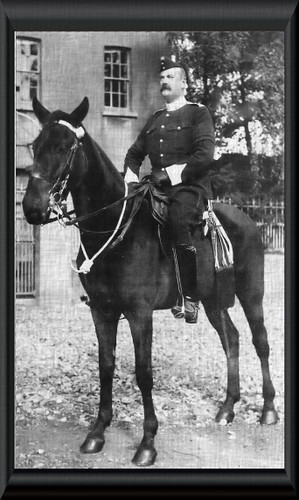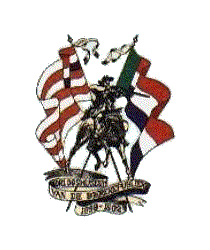Lt Col MacCarthy O'Leary W


Lieutenant-Colonel William MacCarthy O'Leary
1st Battalion South Lancashire Regiment
born 6th January, 1849 Killed in action at Pieter's Hill. 27th Feb. 1900. Aged 51.
Lieutenant Colonel William MacCarthy O'Leary - the third son of Mr. John MacCarthy O'Leary, D.L. of Coomlagne, County Cork and Jane daughter of John O'Connell of Greenagh ( and widow of O'Donoghue of the Glens ) was born on the 6th January, 1849. Educated at Stoneyhurst College, Lancashire, he joined the 82nd Regiment, Prince of Wales Volunteers (now the 2nd Battalion South Lancashire Regiment), as an ensign in April, 1869, and became Captain in March, 1878, having previously filled the post of Musketry Instructor to the battalion for four years. In January, 1883, Captain MacCarthy O'Leary was appointed Adjutant to the 9th Lancashire Volunteers at Warrington, and with them he served five years, with advantage to the corps and great credit to himself, being equally respected by both officers and men. He was a thorough disciplinarian. He was appointed Major in August 1888, at the expiration of his term as Adjutant, and he was posted to the 1st Battalion South Lancashire Regiment (the old 40th), then at Portsmouth, and with them he served in Jersey, and at several stations in Ireland. In November, 1888, he was appointed to the command of the battalion, and in autumn of 1898 he took his corps to the manoeuvres at Salisbury Plain, where he was highly complimented on the efficiency and smart appearance of his men, and upon the skilful manner in which he handled them.
Thence the 1st South Lancashire moved to Preston, where they became distinguished by their prowess on the football field, and in 1899 the battalion won the Army Cup. The warm reception given to the team at Preston on bringing home that trophy is still remembered. While in service at Preston, Lieutenant Colonel O'Leary had an opportunity of renewing his acquaintances with the 1st Vol. Batt. South Lancashire Brigade, in which he was always interested, and it was a source of much gratification to him to be asked to present the annual prizes to the members of the corps in December 1898, when he met many old friends.
Lieutenant Colonel O'Leary married, in 1878 - Mary daughter of the late Mr. Hefferman Considine, of Derk, County Limerick, and had three sons and two daughters. The eldest son John was a Lieutenant in his father's regiment, the 1st South Lancashire's, and served in India. The second son Heffernan William Denis, known as Donogh - also served his Majesty as a Second Lieutenant in the 87th Royal Irish Fusiliers and won the DSO and MC
On the death of his father in 1896, Lieutenant Colonel William O'Leary succeeded to the family estate and in 1897 he was appointed a Deputy-Lieutenant of his native county of Cork.
Soon after the declaration of war in 1899 - he took part with them in most of the engagements for the relief of Ladysmith. At Pieters Hill, on the 27th February, 1900, the South Lancashire's much distinguished themselves. They carried the hill, and opened the road to Ladysmith, as General Sir Redvers Buller reported in his dispatch of February 28th; "The main position was magnificently carried out by the South Lancashire's about sunset."
But in this final and successful attack, Lieutenant Colonel O'Leary was shot dead - close to the enemy position while leading his men to victory. The World of the following week wrote:- "It would be impossible to exaggerate the feelings of sorrow with which all ranks of the 1st Battalion South Lancashire Regiment will have laid the remains of their much loved commanding officer to rest after the last days fighting for the relief of Ladysmith. Lieutenant Colonel O'Leary was one of the most popular commanding officers of the whole service. He was a trusted friend of every officer, non-commissioned officer and man serving under him, entered into all their sports, and never thought of sparing himself where the interests of his Battalions were concerned. Though one of the tallest men in the army, he was also the most active, and it was largely due to his encouragement of sport that the 1st South Lancashire had established such a reputation for themselves as cricket and football players, in both of which games they excelled, as Lieutenant Colonel O'Leary needed to say, with true Irish humour, "the old 40th should."
He was twice mentioned in dispatches for his services
L. G. February 8th 1901 by General Sir R Buller who refered to Lieutenant Colonel MacCarthy O'Leary as a great loss that the country sustained by his death
Statue of Lieutenant Colonel McCarthy O'Leary (War Memorial)
Sculptor - Alfred Drury
Unveiling - 21 February 1907
Place - Egypt Street Warrington
Precise Location - at the centre of Queens Gardens
Lieutenant Colonel O' Leary is represented in uniform appearing to stride forward. His right arm is shown outstretched in front of him and contains a pair of field glasses, his left hand clutches a rifle by his left side. His gaze is shown right of centre and slightly upwards. Relief of a mourning family alongside a dead soldier lying on a bed with an angel by his head. According to a writer in The Dawn, the likeness is said by those who knew the Colonel best, [that] the artist has succeeded in endowing it with that touch of grandeur and imagination which are so often lacking in statues of this sort
Queens Gardens (along with the nearby Victoria Gardens) were open in 1896 and dedicated on 3rd April 1897 in commemoration of the borough's Incorporation and Queen Victoria's Diamond Jubilee. The statue was unveiled on 21st February 1907, a few years after a nearby street had been named O'Leary Street. This was an honour bestowed upon one man - the statue was erected to commemorate the courage of volunteers from Warrington and Lancashire, and other soldiers of the Prince of Wales' Volunteers who fought in the South African War. The gardens occupy the centre of the square and were laid out in 1897.
The granite and statue were placed by the Borough Surveyor. Before the unveiling ceremony the statue was hidden from view by a huge Union Jack Flag. The unveiling of the statue was preceded by a Requiem Mass at St. Mary's church, attended by the Mayor and the town council. At a quarter to twelve a procession of mounted Volunteers, Colonels and General Buller moved up Bridge Street and Sankey Street to the Town Hall. Here, it was met by the chairman of the War Memorials Committee, the Mayor, Committee and Town Council. The procession then continued to Parr Hall for a luncheon in the General's Honour. From here, the group moved as best they could through the crowded streets to the Queen's Gardens. The ceremony itself appears to have been filled with pomp and circumstance. A military square, four sides lined with soldiers from the regiment, acting as the Guard of Honour with their flag, bearing the names of famous victories.
Within the square stood the two sons of Lieutenant Colonel O'Leary, a blaze of officers, members of the War Memorial Committee and their wives; beyond them gathered a group of veterans with friends and subscribers; beyond these, the crowd thronged to get a better look at the proceedings. Henry Roberts, the chairman of the War Memorial Committee called upon General Buller to unveil the statue. The artist, Alfred Drury, handed him the white cord and to a burst of cheers the covering fell from the statue. There was a grasp of amazement from the crowd. The crowd began to sing, 'When our heads are bowed with woe', which merged with the band's 'The Last Post'. Many speeches followed, with the mayor describing it as 'the very noble monument'